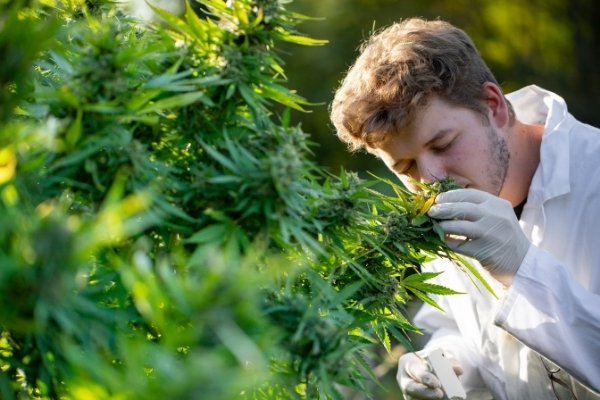To keep neighbors and regulators happy, operators must find better solutions to cannabis cultivation’s odor problem. Can new odor control technologies solve this growing issue?
Odor control for today’s commercial cannabis cultivator is just as critical as it was for the traditional black market grower. In the good old days of underground grow ops, a stinky operation was likely to get shut down. And today, the story isn’t much different, only at an industrial scale.

ODOR ABATEMENT TECHNOLOGY RAPIDLY ADVANCING FOR CANNABIS CULTIVATORS
As cannabis and hemp legislation opens up massive market potential, there is a growing urgency to find new odor control technologies that can work for facilities that can cover tens (if not hundreds) of thousands of square feet.
Technologies implemented in grow rooms across the country include carbon filtration, bipolar ionization, and sealed grow room design:
Carbon Filtration:
Most operations use some form of carbon filter. In essence, it’s a filtration system filled with activated carbon, which sequesters volatile compounds through absorption.
As one of the oldest forms of odor control, this technology has evolved in recent years to adapt to the sheer size and scope of commercial operations. For example, the high humidity of a large-scale greenhouse is a challenging factor for the traditional carbon scrubbers used in the industry.
According to Dr. William Vizuete, Chief Scientific Officer at Pacific Environmental Analytics in Cannabis Business Times, new filtration technology should start with a leaf enclosure test. This measurement determines which volatile organic compounds (e.g., terpenes) are expressed and at what growth stage—details that help an engineer assess the type of filter required and estimated loads.
Envinity is an air purification company working with the cannabis greenhouse industry in Carpinteria Valley, California. It has also extensively studied “the behavior of the odor particle of various odorous plants” to develop its carbon filter and purification technology specifically for cannabis.
According to a recent article highlighting the new odor ‘ceasefire’ in Carpinteria Valley, the newly installed scrubbers use pre-filters and ultraviolet light to extend the life of the carbon filter.
Developed through extensive and localized R&D, these carbon filters aim to resolve the ongoing complaints in the area about smelly cannabis cultivation.
Bipolar Ionization:
Bipolar ionization technology, from the likes of companies like Plasma Air, deploys positive and negatively charged ions into the localized environment. As a result, smaller airborne particulates clump together into larger masses, charged up by the ionization.
These larger particles’ odor-causing contaminants get caught within standard filters (like activated carbon designs) used within the HVAC system.
Plus, the system creates oxygen ions, which naturally oxidize (degrade) the common odorous aerosols produced through cannabis cultivation.
According to Plasma Air, bipolar ionization technology is effective for small particles with a 99 percent success rate compared to most other filtration and odor control solutions. It’s also said to be more cost-effective from OpEX and CapEX perspectives.
Sealed Grow Rooms (Controlled Environment Agriculture):
A final critical component to odor management in and around an indoor cannabis facility is the strict implementation of sealed spaces and a closed-loop HVAC system. Although not applicable for greenhouses, sealed grow rooms ensure no outside exhaust, with air filtered, purified, supplemented, and recirculated back into the space. Controlled indoor environments, widely used in cannabis cultivation, are beneficial for keeping pests, disease, and, importantly, odors at bay.
Andrew Cornwall, a partner in Rose Mary Jane, a multi-state retailer, and cultivator, based in Oklahoma, maintains the protocols around sealed rooms, offering more than just pest control and cleanliness. In his experience, sealed grow rooms ensure no odors leave the space, ensuring happy neighbors no matter where the operation is located.
Cornwall explained that Rose Mary Jane’s current operations in Oklahoma are smell-free, all thanks to a well-controlled indoor environment. He detailed, “We are not exhausting the smelly air, and the added benefit for us with that is we aren’t bringing in contaminated air. Actually sealing the smell in at the point of the source. So we don’t have to deal with charcoal filters, ductwork, and fans.”
Cornwall did importantly highlight that different markets require different odor abatement plans. For example, in Maine, where Rose Mary Jane is expanding operations, they may need to implement additional layers simply due to local regulations. However, he maintains, “Our facility won’t smell because we keep our grow rooms, and we keep our dry rooms sealed.”

FACILITY CONSIDERATIONS START FROM THE GROUND UP
When considering plans for odor control, cultivators and producers need to consider the entire operation, not just the grow rooms. Therefore, odor mitigation plans, typically a requirement within any legal market, need to cover all aspects of the facility, including cultivation rooms, trim rooms, drying rooms, packaging spaces, storage areas, and general HVAC for the common areas.
A mitigation plan (also called an odor abatement plan) details what technologies are applied and where. They drill down into the nitty-gritty aspects, including expected rate of exchange (CFM), filter replacement schedule, and general maintenance requirements.
The cannabis sector has long ago outgrown the typical odor control technologies suitable for an illegal basement grow op. Even the conventional carbon filters are no longer suitable for commercial and industrial-sized operations.
New technologies, including highly customized activated carbon filters, bipolar ionization, and hermetically sealed grow rooms with closed-loop HVAC systems, are required.

